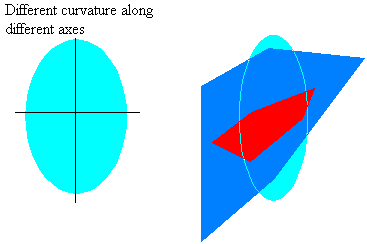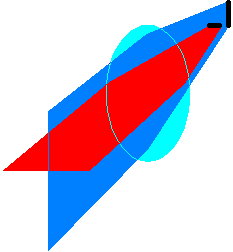
Like coma, in astigmatism, a source that strays from the optical axis creates rays that get focussed in different places.
Astigmatism occurs when the lens has different curvatures in different directions. Although this does not apply to our spherical lenses, astigmatism is nonetheless interesting to see.
Recall our lens-makers' equation.

The right hand side plays the role of 1/f, the inverse of the focus. Decreasing the radius of curvature of Surface 1 thus increases 1/f and decreases f.
Consider the lens below, where the lens along the horizontal axis has a smaller radius of curvature than along the vertical.

The focus for rays along the horizontal plane (red) is thus closer to the lens than the focus for the rays along the vertical plane (blue). Both planes intersect the optical axis of the lens.
A more startling example of astigmatism is when the object does not lie on either of the planes above. This is usually referred to as oblique astigmatism. Then, the resulting image of a point is similar to a plus sign.

The source object is at the intersection of the horizontal and vertical planes, which do not lie along the optical axis. The different curvatures of the lens and spherical aberration combine to "focus" the image point along the dark, think lines.